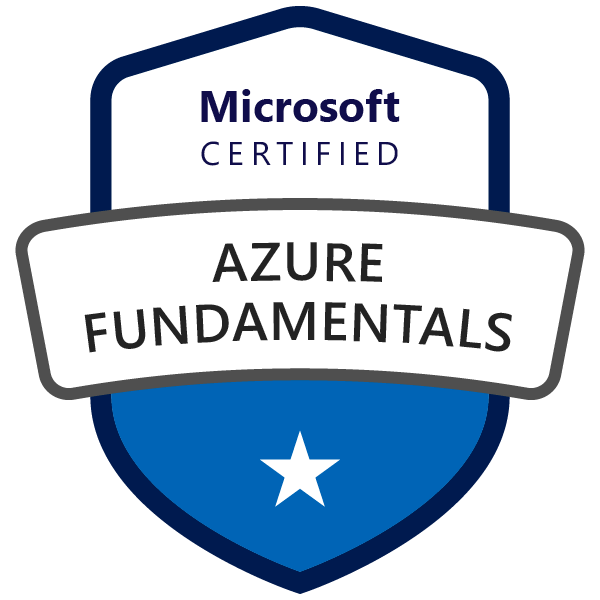Course Description
This course will provide foundational level knowledge on cloud concepts; core Azure services; and Azure management and governance features and tools.
Audience Profile
This course is suitable for IT personnel who are just beginning to work with Azure. This audience wants to learn about our offerings and get hands-on experience with the product. This course primarily uses the Azure portal and command line interface to create resources and does not require scripting skills. Students in this course will gain confidence to take other role-based courses and certifications, such as Azure Administrator. This course combines lecture, demonstrations, and hands-on labs. This course will also help prepare someone for the AZ-900 exam.
Course Outline
Skills at a glance
-
Describe cloud concepts (25–30%)
-
Describe Azure architecture and services (35–40%)
-
Describe Azure management and governance (30–35%)
-
Define cloud computing
-
Describe the shared responsibility model
-
Define cloud models, including public, private, and hybrid
-
Identify appropriate use cases for each cloud model
-
Describe the consumption-based model
-
Compare cloud pricing models
-
Describe serverless
-
Describe the benefits of high availability and scalability in the cloud
-
Describe the benefits of reliability and predictability in the cloud
-
Describe the benefits of security and governance in the cloud
-
Describe the benefits of manageability in the cloud
-
Describe infrastructure as a service (IaaS)
-
Describe platform as a service (PaaS)
-
Describe software as a service (SaaS)
-
Identify appropriate use cases for each cloud service type (IaaS, PaaS, and SaaS)
-
Describe Azure regions, region pairs, and sovereign regions
-
Describe availability zones
-
Describe Azure datacenters
-
Describe Azure resources and resource groups
-
Describe subscriptions
-
Describe management groups
-
Describe the hierarchy of resource groups, subscriptions, and management groups
-
Compare compute types, including containers, virtual machines, and functions
-
Describe virtual machine options, including Azure virtual machines, Azure Virtual Machine Scale Sets, availability sets, and Azure Virtual Desktop
-
Describe the resources required for virtual machines
-
Describe application hosting options, including web apps, containers, and virtual machines
-
Describe virtual networking, including the purpose of Azure virtual networks, Azure virtual subnets, peering, Azure DNS, Azure VPN Gateway, and ExpressRoute
-
Define public and private endpoints
-
Compare Azure Storage services
-
Describe storage tiers
-
Describe redundancy options
-
Describe storage account options and storage types
-
Identify options for moving files, including AzCopy, Azure Storage Explorer, and Azure File Sync
-
Describe migration options, including Azure Migrate and Azure Data Box
-
Describe directory services in Azure, including Microsoft Entra ID and Microsoft Entra Domain Services
-
Describe authentication methods in Azure, including single sign-on (SSO), multi-factor authentication (MFA), and passwordless
-
Describe external identities in Azure, including business-to-business (B2B) and business-to-customer (B2C)
-
Describe Microsoft Entra Conditional Access
-
Describe Azure role-based access control (RBAC)
-
Describe the concept of Zero Trust
-
Describe the purpose of the defense-in-depth model
-
Describe the purpose of Microsoft Defender for Cloud
-
Describe factors that can affect costs in Azure
-
Compare the pricing calculator and the Total Cost of Ownership (TCO) Calculator
-
Describe cost management capabilities in Azure
-
Describe the purpose of tags
-
Describe the purpose of Microsoft Purview in Azure
-
Describe the purpose of Azure Policy
-
Describe the purpose of resource locks
-
Describe the Azure portal
-
Describe Azure Cloud Shell, including Azure Command-Line Interface (CLI) and Azure PowerShell
-
Describe the purpose of Azure Arc
-
Describe infrastructure as code (IaC)
-
Describe Azure Resource Manager (ARM) and ARM templates
-
Describe the purpose of Azure Advisor
-
Describe Azure Service Health
-
Describe Azure Monitor, including Log Analytics, Azure Monitor alerts, and Application Insights
1 Day


